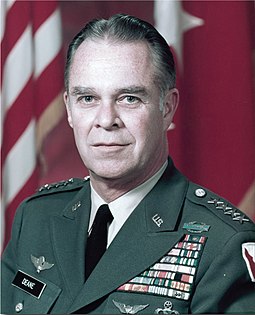A military staff is a group of officers, enlisted and civilian personnel that are responsible for the administrative, operational and logistical needs of its unit. It provides bi-directional flow of information between a commanding officer and subordinate military units. A staff also provides an executive function where it filters information needed by the commander or shunts unnecessary information.
Organization of Japanese forces in the South-East Asian theatre of World War II.

Howell Marion Estes Jr. was a general in the United States Air Force and commander of the Military Air Transport Service, later renamed the Military Airlift Command.

Frederick Carlton Weyand was a general in the United States Army. Weyand was the last commander of United States military operations in the Vietnam War from 1972 to 1973, and served as the 28th Chief of Staff of the United States Army from 1974 to 1976.

Zhang FakuiCBE was a Chinese Nationalist general who fought against northern warlords, the Imperial Japanese Army and Chinese Communist forces in his military career. He served as commander-in-chief of the 8th Army Group and commander-in-chief of NRA ground force before retiring in Hong Kong in 1949.

Sun Lianzhong was a Chinese general during the Warlord Era, Second Sino-Japanese War and Chinese Civil War. Best known for his commanded of the 2nd Group Army in the Battle of Taierzhuang, he had a long career in the army.

Luo Zhuoying was a Republic of China General (二級上將). He was active during the Second Sino-Japanese War and was later the Governor of Guangdong.

John Russell Deane Jr. was a highly decorated United States Army officer with the rank of General. He served as commander of the United States Army Materiel Command.

Frank Fort Everest was a United States Air Force general, and served as Commander, U.S. Air Forces in Europe, and Commander, Tactical Air Command.
Deng Longguang was a KMT general from Guangdong.

Frederic Harrison Smith Jr. was a United States Air Force four-star general who served as Commander in Chief, U.S. Air Forces in Europe (CINCUSAFE) from 1959 to 1961; and Vice Chief of Staff, U.S. Air Force (VCSAF) from 1961 to 1962.

Lieutenant General Charles Bertody Stone III was an officer in the US Air Force. During World War II, he served as Chief of Staff, Headquarters Army Air Forces, China-Burma-India Theater. During the Cold War, he served as Commander, Continental Air Command, Mitchel Field, New York between 1955-1957.

Hunter Harris Jr. was a United States Air Force four-star general who served as Commander in Chief, Pacific Air Forces (CINCPACAF) from 1964 to 1967.

David Arthur Burchinal was a United States Air Force four-star general who served as Deputy Commander in Chief, United States European Command (DCINCEUR), from 1966 to 1973.
Lieutenant General Harbaksh Singh, VrC was a three star General in the Indian Army. As the Western Army Commander, Lt Gen Harbaksh Singh commanded the Indian Army forces and played a key role during the Indo-Pakistani War of 1965. He was awarded the Padma Vibhushan, Padma Bhushan and Vir Chakra.

Lieutenant General Sir Henry Wells, was a senior officer in the Australian Army. Serving as Chief of the General Staff from 1954 to 1958, Wells' career culminated with his appointment as the first Chairman, Chiefs of Staff Committee, a position marking him as the professional head of the Australian Military. He served in this capacity from March 1958 until March 1959, when he retired from the army.

General Sir Charles Phibbs Jones (1906–1988) was a British Army general who reached high office in the 1950s.
Lieutenant General Sir George Sinclair Cole (1911–1973) was a senior British Army officer who achieved high office in the 1960s.
Major General (Thomas) Norman (Samuel) Wheeler was a British Army officer who commanded the 2nd Division from 1964 to 1966.

Herman Nickerson Jr. was a highly decorated officer of the United States Marine Corps with the rank of Lieutenant General. A veteran of several wars, he distinguished himself during the Korean War as Commanding officer, 7th Marine Regiment and received the Distinguished Service Cross, the second highest military award that can be given to a member of the United States Armed Forces for extreme gallantry and risk of life in actual combat with an armed enemy force.

















